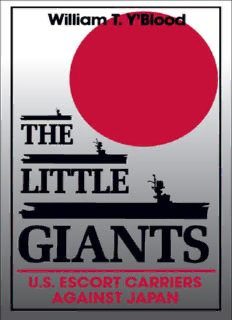
The Little Giants: U.S. Escort Carriers Against Japan PDF
Preview The Little Giants: U.S. Escort Carriers Against Japan
THE LITTLE GIANTS THE LITTLE GIANTS U.S. Escort Carriers Against Japan William T. Y’Blood BLUEJACKET BOOKS NAVAL INSTITUTE PRESS ANNAPOLIS, MARYLAND This book has been brought to publication by the generous assistance of Marguerite and Gerry Lenfest. © 1987 by the U.S. Naval Institute, Annapolis, Maryland All rights reserved. No part of this book may be reproduced or utilized in any form or by any means, electronic or mechanical, including photocopying and recording, or by any information storage and retrieval system, without permission in writing from the publisher. First Bluejacket Books printing, 1999 ISBN 978-1-61251-247-1 The Library of Congress has cataloged the hardcover edition as follows: Y’Blood, William T., 1937– The little giants. Bibliography: p. Includes index. 1. World War, 1939–1945—Aerial operations, American. 2. World War, 1939–1945—Naval operations, American. 3. World War, 1939–1945—Campaigns—Pacific Area. 4. Aircraft carriers—United States. I. Title. D790.Y42 1987 940.54'26 87-7866 CONTENTS Introduction Glossary Prologue 1. Learning the Ropes 2. The Quickening Pace 3. Moving West 4. Approach to the Philippines 5. The Return 6. “They’re Shooting at Us in Technicolor” 7. Death from the Sky 8. Finale at Leyte Gulf 9. Divine Wind—Two Versions 10. A Covey of Kamikazes 11. Visit to a Vile Island 12. The Longest Battle Epilogue Appendix: U.S. Escort Carriers Notes Bibliography Index INTRODUCTION THEY WERE CALLED “jeeps,” “baby flattops,” “two-torpedo ships,” “combustible, vulnerable, expendable,” and other, unprintable, names. They were the CVEs—the U.S. Navy’s designation for aircraft carrier, escort. These ships, envisioned as hardly more than convoy escorts in the beginning, evolved into remarkably versatile vessels. Yes, they were used to escort convoys, but they also hunted submarines, provided air support for invasion forces, ferried men and planes to far-flung bases, delivered replacement aircraft and pilots to the fast carriers of Task Forces 58 and 38, and worked as troop transports. Despite the great activity of the eighty-six vessels built (some finished after the war) to serve all around the world for the United States Navy, their accomplishments, except for one glorious action in October 1944, have never received the publicity and credit that they deserve. Too often the CVE sailors heard comments like the one from a new officer on the Saginaw Bay who had just come from one of the fast carriers: “I don’t know how you take care of that routine here, but I know how it’s done on a carrier!” Too often they saw the headline “Fast Carriers Winning the War”—a headline hard for them to stomach after sending their planes out day after day to pound the enemy defenses in front of the ground forces or to attack skulking submarines. Too often they saw their own deserving shipmates passed over for awards while sailors and airmen on the fast carriers seemed to be raking them in. This lack of recognition may have frustrated or even angered the “jeep” sailors, but it didn’t stop them from doing their jobs and doing them well. History has shown that the fast carriers didn’t win World War II; neither did the Army Air Forces nor army or marine troops. It was a team effort that won the war, and a vital part of this team effort was the escort carriers. Until now, little has been written about their accomplishments, and this book is intended to give the CVEs and their sailors their long-overdue attention. The sources consulted include action reports, war diaries, ships’ histories, air action reports, and so forth. I am greatly indebted to those men, listed in the bibliography, who contributed their personal accounts of service on the “jeeps.” In addition, this book would not have been possible without the help of several people: Henry “Hank” Pyzdrowski of the Gambier Bay/VC-10 Association (a real go-getting organization), Herb Faulkner of the Natoma Bay Association, Bob Zubik and Hank Henderson of the Ommaney Bay Association, and James Dresser. Many, many thanks to these men, who provided me with material and leads to track down, saving me hours of possibly fruitless digging for information. My thanks also to Dr. Dean Allard and his staff, particularly Mike Walker, at the Naval Historical Center’s Operational Archives Branch. A special thanks goes to my editor, Laurie Stearns, who cleared away much of the underbrush. Finally, I must thank my wife, Carolyn, and children, Kent and Laura. They’d been through this rat race before but still gave me much-needed and much-appreciated support. GLOSSARY AA Antiaircraft ACI Air combat intelligence ACV Auxiliary aircraft carrier airedale Flight deck crewman AO Oiler APV Transport and aircraft ferry ASP Antisubmarine patrol ASW Antisubmarine warfare AVG Aircraft tender, general purpose black gang Engine-room crew bogey Unidentified aircraft CAG Air group commander CAP Combat air patrol CarDiv Carrier Division CarTransRonPacCarrier Transport Squadron Pacific CASD Carrier aircraft service detachment CASU Carrier aircraft service unit CIC Combat Information Center CinCPac Commander in Chief Pacific Fleet CO Commanding officer CortDiv Escort Division CruDiv Cruiser Division CSA Commander Support Aircraft CTG Commander of task group CVE Aircraft carrier, escort CVEG Escort carrier air group DD Destroyer DE Destroyer escort “deck” Sea level DesRon Destroyer Squadron F Flagship FDO Fighter director officer FF Force or task group flagship flak Antiaircraft fire GP General-purpose bomb GPM Gallons per minute hedgehog Type of throw-ahead missile launcher HF/DF High frequency direction finding IFF Identification, friend or foe JASCO Joint Assault Signal Company JCS Joint Chiefs of Staff jink To take evasive action in an aircraft KIA Killed in action LCI(G) Landing craft, infantry (gunboat) LCI(R) Landing craft, infantry (rocket) LCT Landing craft, tank LSM Landing ship, medium LSO Landing signal officer LST Landing ship, tank MAG Marine Air Group Magic Code name for U.S. efforts to break the Japanese codes MASG Marine Air Support Group MCVG Marine Carrier Air Group NAS Naval air station OTC Officer in tactical command RAMP Recovery of allied military personnel
Description: